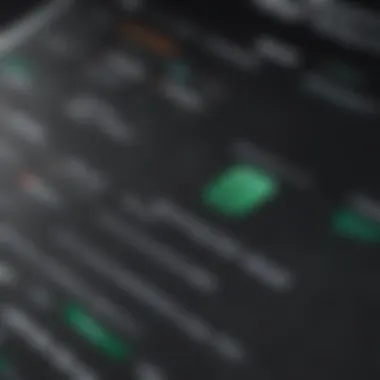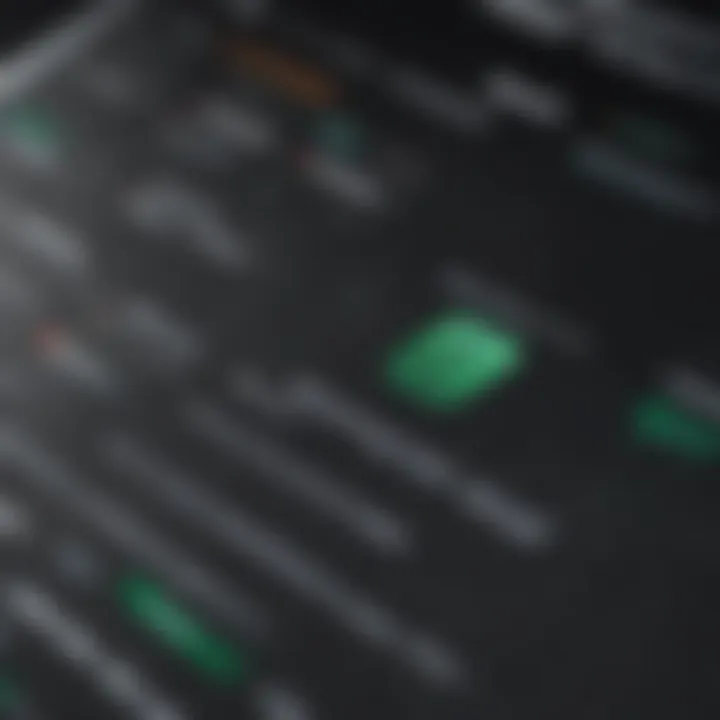Understanding Spotify's Payment Structure: A Comprehensive Analysis


Intro
In recent years, the music industry has undergone dramatic changes due to the rise of streaming platforms. One of the most prominent services is Spotify, which has reshaped how listeners access music. However, a pressing question has emerged: how much do artists really earn from their total streams? This inquiry leads to a deeper understanding of Spotify's payout system.
Gregory, a music artist with a blossoming career, says, "The revenue from Spotify has puzzled me. It is not as straightforward as it seems. I wish to understand it better."
This article aims to clarify the complexities of Spotify's payment structure, the mechanics behind its financial ecosystem, and how these impact artists and the broader music industry.
Payment Structure Overview
Spotify's payment structure is not a one-size-fits-all model. The platform uses a pro-rata system, which means that your earnings depend heavily on the total streams of all artists in a given timeframe, as well as the type of account that the listener uses. Here are some key points to consider:
- Spotify pays per stream, but not equally for every stream. The total payout for all streams in a given period is aggregated and then divided among artists based on a specific formula.
- Artist earnings also depend on their market share. More popular artists generally earn more because they represent a larger portion of total streams.
- Stream counts and listener habits matter greatly. The type of user account (Premium or Free) affects the payout as Premium subscribers contribute more financially compared to those on the ad-supported layer.
Factors Influencing Artist Payments
Various factors influence how much an artist earns from Spotify. Understanding these can help artists optimize their strategy on the platform. Here are a few of those factors:
- Geographical Distribution: Different regions come with varied payout rates. Streaming from countries with higher revenue potential usually results in better payouts.
- User-Artist Interaction: Increased engagement, such as playlist placements and social media promotion, can drive more streams and improve earnings.
- Contractual Agreements: Standard contracts with labels or distributors can significantly alter the net revenue an artist receives. Artists signed to labels often see a lesser portion of the revenue than independent artists who manage their distribution.
"Understanding the payout system is crucial for artists. It is not just about how many streams you get; it is about how those streams translate into actual income."
Comparison with Other Streaming Platforms
When comparing Spotify with rival streaming services like Apple Music and Amazon Music, the payout structures can vary. Some key differences include:
- Payout Rates: Apple Music often offers higher per-stream payouts than Spotify, primarily because it charges a flat subscription fee without ad-supported tiers.
- User Base Growth: Spotify has a more diversified user base worldwide, leading to varying payments that are usually lower for lesser-known artists.
- Promotional Opportunities: Services like Tidal focus more on exclusive releases and artist ownership, which can influence earnings differently than Spotify's model.
Implications for the Music Industry
The ramifications of Spotify's payment structure extend beyond individual artists. It influences the entire industry landscape including record labels, marketers, and independent musicians. Here are a few implications:
- Changing Role of Labels: As artists begin to rely more on platforms like Spotify for income, traditional record labels may have to adapt their business models to remain relevant.
- Emergence of Independent Artists: The facilitating of direct connections to fans via streaming platforms allows independent and novice musicians to carve out a space for themselves without the need for significant label backing.
- Challenges in Monetization: Many artists still struggle to monetize their work effectively. This has led to growing conversations about fair pay and the need for reform in the streaming landscape.
Prolusion to Spotify's Payment Model
In the digital age, the music industry has undergone significant transformation. The rise of music streaming services has changed how artists earn revenue and how consumers access music. Understanding Spotify's payment model is crucial not only for musicians but also for fans and industry professionals. This section explains the components of Spotify's payment structure. It highlights the profit-sharing dynamics, and the financial implications for creators.
An Overview of the Music Streaming Industry
The music streaming industry has evolved rapidly over the last decade. Platforms like Spotify, Apple Music, and Amazon Music have become mainstream. They allow users to listen to vast libraries of songs via subscription. This shift from physical sales to streaming has reshaped revenue models.
Recent studies indicate that streaming contributes to a major portion of overall music revenue. According to the Recording Industry Association of America, streaming services account for 80% or more of total industry earnings today. While this has expanded access to music, it has complicated financial returns for artists. Many musicians find it challenging to navigate their its revenue implications.
Spotify's Role in the Market
As one of the largest music streaming platforms, Spotify plays a vital role in shaping industry norms. Launched in 2008, its growth has been remarkable. By 2023, Spotify reported over 500 million active users. This includes around 250 million premium users who pay for ad-free listening experiences.
Spotify's model is designed not just to supply music, but to create a platform for discovery. Its complex algorithm offers personalized playlists and recommendations to engage users. Consequently, artists can reach wider audiences than ever before.
This expansive reach raises questions about compensation. Spotify's payment structure involves intricate relationships with record labels and music publishers. As such, artists often express concerns about the clarity of payment models and whether they can sustain their careers solely through streaming royalties.


Understanding these dynamics is vital for artists looking to maximize their earnings. By dissecting Spotify's payment model, one can uncover the intricacies that underline not only individual payouts but also the systemic realities that impact artist revenue across the streaming platform.
Understanding Stream Payments
Understanding stream payments is vital for grasping how Spotify compensates artists. This section serves as a foundation for artists, industry professionals, and listeners who are curious about the financial mechanics behind streaming. The way Spotify pays musicians directly impacts their livelihood and the overall health of the music ecosystem. Knowing the intricacies of stream payments demystifies some common misconceptions and helps stakeholders make informed decisions about their engagements with the platform.
Defining a Stream
A stream is essentially a single instance of a listener playing a song on Spotify's platform. The definition may seem simple, but it plays a crucial role in calculating payouts. Each time a song is played for at least 30 seconds, it is counted as a stream. This method of counting highlights the importance of listener engagement. Higher stream counts can lead to increased visibility for artists, which may result in more followers and future streams. This relationship makes every single stream significant in the context of an artist's career.
Average Payout Per Stream
The average payout per stream on Spotify varies. Reports often suggest that the figure ranges between $0.003 to $0.005 per stream. However, this value is not fixed and can fluctuate based on various conditions. Factors such as the artist's contract, the type of distribution deal they have, and the listener’s subscription plan can impact the actual payout amount. Even with relatively small payouts, large numbers of streams can accumulate to significant amounts for popular songs. Understanding this average payout is essential for artists planning on maximizing their revenue from streaming.
Factors Influencing Payout Amounts
Several factors influence the total payouts that artists receive from Spotify. Recognizing these can assist artists in strategically enhancing their revenue streams.
User Location
User location plays a significant role in determining payouts. Different countries have various agreements regarding music licensing and royalties. For example, users in the United States may generate higher payouts compared to users in countries with different licensing laws. Additionally, Spotify's subscription revenue can vary greatly from region to region. Understanding how user location affects payouts can help artists tailor their marketing and distribution strategies.
Subscription Type
The subscription type is another critical factor. Spotify offers both free and premium subscription models. Artists generally earn more from streams that come from premium users because those streams are tied to paid subscriptions, which generate higher revenue for Spotify. Thus, the type of subscribers who listen to an artist’s music can directly affect the artist's earnings. As streaming models evolve, artists might want to focus efforts on converting free listeners into premium subscribers.
Playlists and Discoverability
Playlists enhance discoverability, which is crucial for stream payments. Tracks that get included in popular playlists can see a considerable boost in their stream counts. Spotify's algorithms favor songs that engage listeners, so being featured in curated playlists can lead to increased exposure. This aspect emphasizes the importance of strategic marketing and networking within the platform. Without playlist placements, even talented artists might struggle to achieve noticeable earnings through streams alone.
Understanding these factors profoundly impacts how artists strategize their interactive efforts with Spotify, thus maximizing their revenue potential.
Revenue Distribution Process
Understanding the revenue distribution process is critical when analyzing Spotify's payment structure. This process explains how the money generated from streaming is allocated among various stakeholders. It impacts artists directly and shapes their earning potential in the highly competitive music industry. By breaking down this process, we can grasp the complexities involved and acknowledge the benefits and considerations for artists navigating this system.
How Revenue is Generated
Revenue on Spotify primarily comes from two main sources: subscriptions and advertisements. Users can choose between a paid subscription or a free ad-supported model. For premium subscribers, Spotify receives a monthly fee. This revenue is significant as it forms a large part of the funds available for distribution to rights holders. In the ad-supported model, advertisers pay Spotify for ad placements which further contributes to this revenue pool.
Factors in Revenue Sharing
Spotify’s revenue is not distributed directly to artists. Instead, it is shared among various parties such as record labels, publishers, and distributors. These relationships dictate how much artists ultimately earn.
Record Labels
Record labels play a major role in the revenue sharing model. They are the primary controllers of the music catalog. Labels take a substantial cut of the revenue before it reaches the artist. This is often seen as a disadvantage because it reduces the amount artists can earn from their streams. However, working with a reputable label can provide advantages like marketing support and wider distribution.
Publishing Rights
Publishing rights cover the ownership of song compositions. This aspect ensures that songwriters and composers receive a fair share of the revenue generated from their creations. The value of these rights in the distribution process is significant. They ensure that those who originally created the content are compensated. However, the complexities of ownership can sometimes lead to disputes between songwriters and publishers, which complicates the payouts for artists.
Distribution Deals


Distribution deals refer to agreements between artists and distributors that facilitate the release of music on streaming platforms like Spotify. These deals are essential because they determine how royalties are split. Many independent artists opt for distribution through companies like DistroKid or TuneCore, which can offer advantageous terms compared to traditional label contracts. Nevertheless, the terms of these deals can vary widely, and understanding them is crucial for artists wanting to maximize their income.
The dynamics of revenue distribution can greatly affect artists' financial outcomes, making it essential for them to understand their agreements thoroughly.
By examining the intricacies of revenue generation and the various stakeholders involved, we begin to understand the financial ecosystem of Spotify. This understanding highlights the importance for artists to negotiate their contracts carefully to ensure fair compensation for their work.
Comparative Analysis of Streaming Services
The comparative analysis of streaming services is crucial in understanding how different platforms operate within the music streaming ecosystem. Each service has its own unique payment structure, which affects how artists receive compensation. By examining these differences, we can gain insights into the overall landscape of music monetization. This section specifically explores Spotify, Apple Music, and Amazon Music, with a focus on how their approaches impact artist earnings and user experiences.
Spotify vs. Apple Music
Spotify and Apple Music are two leading contenders in the market, yet their payment structures diverge notably. Spotify operates on a pro-rata system, where royalties are pooled together and distributed based on overall market share. Apple Music, contrastingly, pays artists directly per stream, which can yield different financial outcomes for musicians.
Key Differences:
- Payment Model: Spotify's model rewards based on total streams, while Apple Music focuses on individual streams.
- Subscription Fee Allocation: Apple Music offers a more straightforward allocation of fees, directly linking proceeds to listening habits.
- User Base Influence: Spotify has a larger user base, potentially impacting payout amounts despite its pro-rata model.
Both platforms place high importance on exclusive content. Apple Music often secures artist exclusives and features that might drive up subscriptions, while Spotify invests in playlists and algorithm-driven discovery to attract listeners. This fosters an ongoing competition for artists' attention and ultimately shapes earnings.
Spotify vs. Amazon Music
The comparison between Spotify and Amazon Music also yields interesting observations. Amazon Music has been growing rapidly, offering competitive pricing and unique bundling options for Amazon Prime members.
Key Differences:
- Revenue Distribution: Amazon’s streaming service has a similar model to Spotify but incorporates its Prime membership to enhance promotions and visibility.
- Marketplace Strategies: Unlike Spotify, Amazon utilizes its vast e-commerce platform, which allows artists to engage in merchandising more easily.
- Promotional Mechanisms: Spotify leverages its algorithm-driven playlists, while Amazon Music relies heavily on discounts and prime trials to attract new users.
Both services impact artists differently. For example, Amazon’s integration with retail might lead to diverse revenue streams, while Spotify’s focus on playlist visibility can increase streaming numbers.
Impact on Artists' Earnings
The earnings of artists can vary significantly between these platforms due to the fundamental differences in payment structures and user engagement strategies. The complexity of revenue generation complicates how musicians budget their income.
Factors influencing earnings include:
- Listening Patterns: Services like Spotify rely on playlists and algorithm recommendations, so how often a song appears in these formats can dictate its total streams.
- Engagement Levels: More engaged listeners generally lead to higher payout potential as each individual stream becomes valuable in broader calculations.
- Subscription Models: Platforms with a significant number of paid subscribers tend to generate higher royalties per stream, increasing artist income.
"Understanding how different platforms impact artist earnings is key to navigating the modern music industry."
These variances in payment systems, user engagement, and marketing strategies need attention, especially when artists consider their strategies for releasing music and building careers. As the landscape evolves, ongoing analysis of these competitive dynamics will be essential for artists and industry stakeholders alike.
Implications for Artists
Understanding the implications of Spotify's payment structure is crucial for artists navigating the modern music landscape. The intricate financial ecosystem affects how artists generate revenue and sustain their careers. With the rise of streaming, it has become essential to grasp the diverse challenges and opportunities presented by platforms like Spotify.
The Challenge of Low Payouts
Many artists express concern regarding the low payout rates from Spotify. Typically, streaming platforms pay artists a fraction of a cent per stream. For example, the average payout can range from $0.003 to $0.005. Such rates generate frustrations among musicians, especially those not signed to major labels.
Often, these low payouts do not cover the costs associated with producing music, leading some artists to struggle financially. Small independent artists may find it particularly difficult to make ends meet, as they rely heavily on streaming revenue. This results in a relentless cycle of financial distress, forcing artists to search for alternatives to monetize their work.


The Necessity for Touring and Merchandising
Due to inadequate streaming payouts, many artists must seek additional revenue sources. Touring and merchandising are vital for artists aiming to supplement their income. Concert tours can generate substantial profit, especially if they establish a loyal fan base. Performing live shows often allows artists to earn more in one night than numerous streaming plays combined.
Furthermore, merchandising has turned into an effective strategy for artists to connect with fans and create additional income streams. This includes selling items such as t-shirts, posters, and exclusive content. However, these avenues also entail costs and require significant effort in marketing and logistics.
Innovative Strategies for Revenue Generation
Artists are increasingly adopting innovative strategies to improve their financial sustainability. Crowdfunding through platforms like Patreon allows fans to directly support their favorite artists and, in return, receive unique content or experiences. This model enhances artist-fan relationships and provides a reliable revenue stream.
Another approach is collaborative releases. By partnering with other artists or brands, musicians can tap into new audiences and share costs for promotional activities. Such collaborations can also create unique content that attracts media attention.
In addition, leveraging social media to promote music and merchandise has become essential. Platforms like Instagram and TikTok allow artists to showcase their work, engage with fans, and develop a recognizable brand. Creatively using these platforms can translate into tangible financial support.
It is clear that understanding the implications of Spotify’s payment structure leads to important insights for artists. Low payouts and dependence on streaming have pushed musicians to innovate in their revenue strategies, focusing on tours, merch, and direct fan engagement.
By analyzing these implications, artists can adapt to a challenging environment and devise ways to thrive financially in the evolving music industry.
Future Trends in Music Streaming Payments
The landscape of music streaming payments is shifting rapidly. This section highlights anticipated transformations and their significance in shaping the future of artist remuneration and industry dynamics. As technology and consumer behavior evolve, the methods through which artists earn from their music are likely to adapt. This reflects a broader trend towards payment models that could prove more equitable and sustainable for musicians.
Evolving Business Models
In recent years, several streaming platforms have begun to explore new business models. These include hybrid approaches that combine subscription services with ad-supported offerings. For example, services like Spotify continue to innovate their tiered subscription plans, allowing users to choose between free access with advertisements and various paid plans. These changes can have significant implications for how artists receive payment.
Additionally, platforms might adopt blockchain technology to increase transparency in revenue distribution. Such systems can ensure artists are compensated more accurately and promptly. By removing intermediaries, artists could receive a greater share of revenue, directly from listener transactions.
Potential Reforms in Payment Structures
The current payment methods have faced criticism for being insufficiently favorable to artists, especially those emerging or less popular. As a result, there is growing advocacy for reforms.
One proposed reform is shifting from a pro-rata payment system to a user-centric model. In this model, subscriber fees would go directly to artists that the listener has streamed. This shift could mean more predictable earnings for musicians, especially niche artists who attract dedicated followers.
Moreover, platforms might consider increased transparency in calculations. Clarifying payout calculations can build trust and understanding with artists about how they earn from their music.
Consumer Behavior and Its Impact
Consumer behavior significantly influences streaming payment structures. Users are increasingly demanding more control over their listening experiences and are critical of platforms that do not provide clear information on artist earnings.
This growing awareness is prompting streaming services to actively communicate the ways in which earnings are calculated. Artisits and listeners alike desire clarity to understand how their choices impact earnings. In kind, platforms might respond by offering more detailed dashboards for artists, showcasing their performance over time and potential revenue indicators.
"The future of music payments relies heavily on consumers understanding their role in supporting artists they love."
The End
This article has explored the complex and often opaque payment structure within Spotify, shedding light on the way artists earn their revenue. Understanding this structure is crucial not only for artists but also for stakeholders in the broader music industry. It illuminates the challenge of earning a sustainable income through streaming services, which has become the norm today.
Summary of Key Insights
The key takeaways from the analysis include:
- Payout Per Stream: The average payout per stream is notably low, causing artists to seek supplementary income through touring and merchandising.
- Factors Influencing Payments: Artist earnings are influenced by factors such as geographical location, the type of subscription chosen by listeners, and placement on playlists. These elements critically shape the financial landscape for musical creators.
- Comparative Payments: In a comparative context, Spotify's payments stand against those from competitors like Apple Music and Amazon Music, revealing disparities that artists must navigate.
- Future Potential for Reform: As the industry evolves, there is potential for reforms in the payment structure. Understanding possible future changes can help artists strategize their careers efficiently.
Final Thoughts on the Future of Streaming Payments
The future of streaming payments will likely continue to shift alongside changing consumer behaviors and technological advancements. It may be imperative for streaming platforms to reassess the fairness of their payment models to keep artists engaged and supported. Further, as artists adapt to these financial realities, they may innovate new methods of revenue generation, blending traditional and digital platforms more seamlessly. The dynamic between streaming services and artists is evolving, and both parties need to stay informed to thrive in the competitive market.
"Understanding payment structures is key for artists navigating the complexities of digital music distribution."



